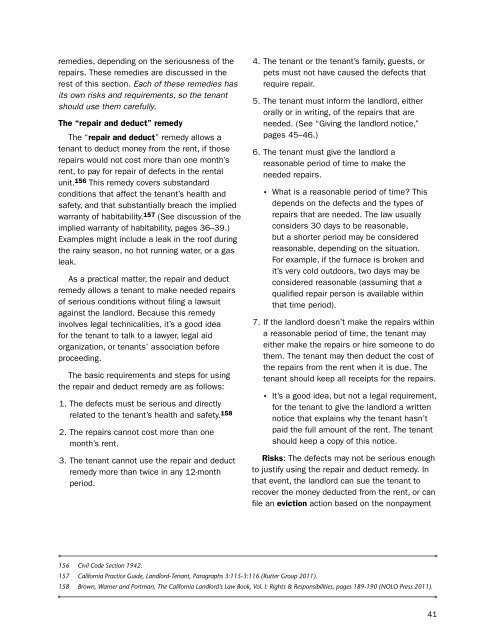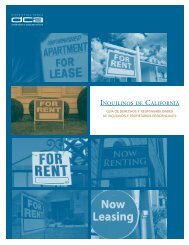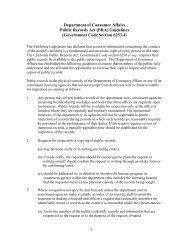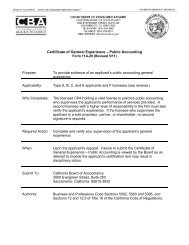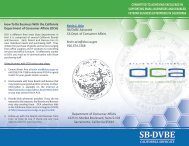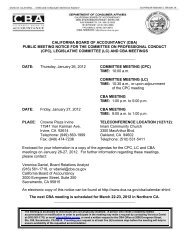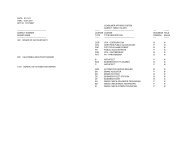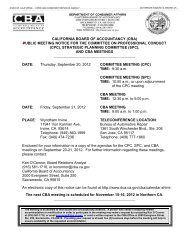California Tenants - Department of Consumer Affairs - State of ...
California Tenants - Department of Consumer Affairs - State of ...
California Tenants - Department of Consumer Affairs - State of ...
You also want an ePaper? Increase the reach of your titles
YUMPU automatically turns print PDFs into web optimized ePapers that Google loves.
emedies, depending on the seriousness <strong>of</strong> the<br />
repairs. these remedies are discussed in the<br />
rest <strong>of</strong> this section. Each <strong>of</strong> these remedies has<br />
its own risks and requirements, so the tenant<br />
should use them carefully.<br />
the “repair and deduct” remedy<br />
the “repair and deduct” remedy allows a<br />
tenant to deduct money from the rent, if those<br />
repairs would not cost more than one month’s<br />
rent, to pay for repair <strong>of</strong> defects in the rental<br />
unit. 156 this remedy covers substandard<br />
conditions that affect the tenant’s health and<br />
safety, and that substantially breach the implied<br />
warranty <strong>of</strong> habitability. 157 (see discussion <strong>of</strong> the<br />
implied warranty <strong>of</strong> habitability, pages 36–39.)<br />
examples might include a leak in the ro<strong>of</strong> during<br />
the rainy season, no hot running water, or a gas<br />
leak.<br />
As a practical matter, the repair and deduct<br />
remedy allows a tenant to make needed repairs<br />
<strong>of</strong> serious conditions without filing a lawsuit<br />
against the landlord. because this remedy<br />
involves legal technicalities, it’s a good idea<br />
for the tenant to talk to a lawyer, legal aid<br />
organization, or tenants’ association before<br />
proceeding.<br />
the basic requirements and steps for using<br />
the repair and deduct remedy are as follows:<br />
1. the defects must be serious and directly<br />
related to the tenant’s health and safety. 158<br />
2. the repairs cannot cost more than one<br />
month’s rent.<br />
3. the tenant cannot use the repair and deduct<br />
remedy more than twice in any 12-month<br />
period.<br />
4. the tenant or the tenant’s family, guests, or<br />
pets must not have caused the defects that<br />
require repair.<br />
5. the tenant must inform the landlord, either<br />
orally or in writing, <strong>of</strong> the repairs that are<br />
needed. (see “Giving the landlord notice,”<br />
pages 45–46.)<br />
6. the tenant must give the landlord a<br />
reasonable period <strong>of</strong> time to make the<br />
needed repairs.<br />
• What is a reasonable period <strong>of</strong> time? this<br />
depends on the defects and the types <strong>of</strong><br />
repairs that are needed. the law usually<br />
considers 30 days to be reasonable,<br />
but a shorter period may be considered<br />
reasonable, depending on the situation.<br />
For example, if the furnace is broken and<br />
it’s very cold outdoors, two days may be<br />
considered reasonable (assuming that a<br />
qualified repair person is available within<br />
that time period).<br />
7. if the landlord doesn’t make the repairs within<br />
a reasonable period <strong>of</strong> time, the tenant may<br />
either make the repairs or hire someone to do<br />
them. the tenant may then deduct the cost <strong>of</strong><br />
the repairs from the rent when it is due. the<br />
tenant should keep all receipts for the repairs.<br />
• it’s a good idea, but not a legal requirement,<br />
for the tenant to give the landlord a written<br />
notice that explains why the tenant hasn’t<br />
paid the full amount <strong>of</strong> the rent. the tenant<br />
should keep a copy <strong>of</strong> this notice.<br />
risks: the defects may not be serious enough<br />
to justify using the repair and deduct remedy. in<br />
that event, the landlord can sue the tenant to<br />
recover the money deducted from the rent, or can<br />
file an eviction action based on the nonpayment<br />
156 Civil Code Section 1942.<br />
157 <strong>California</strong> Practice Guide, Landlord-Tenant, Paragraphs 3:115-3:116 (Rutter Group 2011).<br />
158 Brown, Warner and Portman, The <strong>California</strong> Landlord’s Law Book, Vol. I: Rights & Responsibilities, pages 189-190 (NOLO Press 2011).<br />
41


